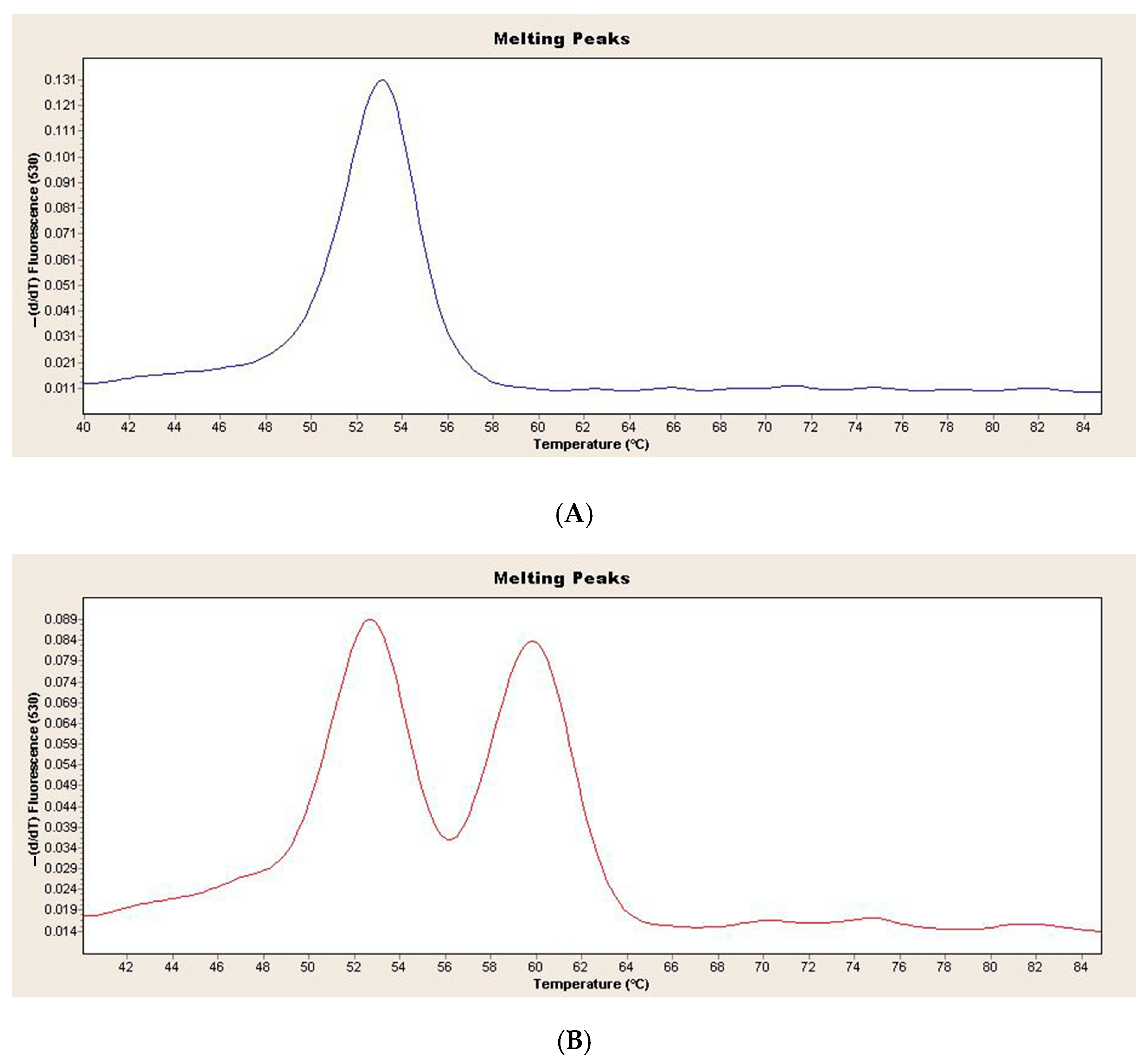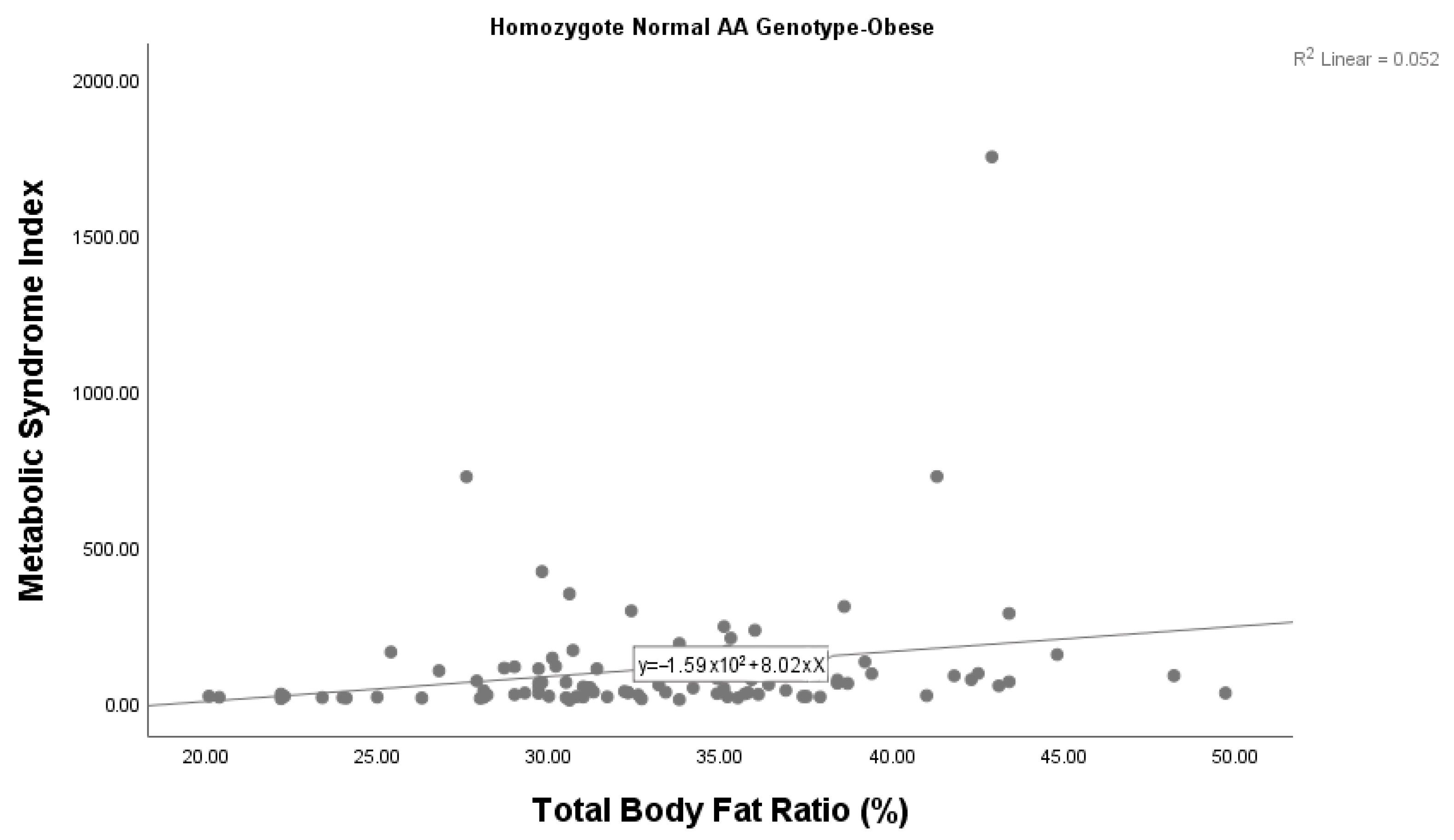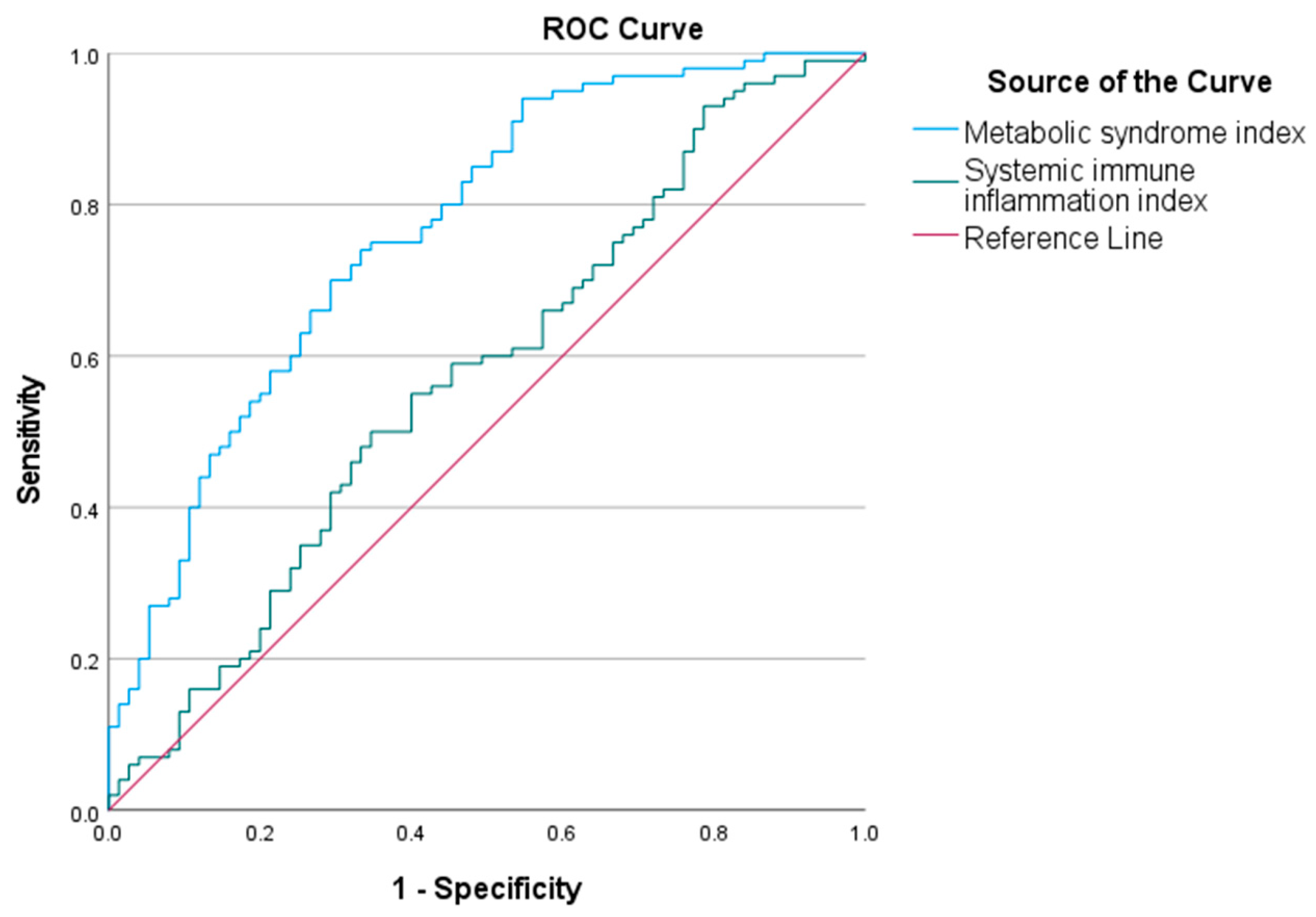Association of Lipoprotein A rs10455872 Polymorphism with Childhood Obesity and Obesity-Related Outcomes
Abstract
1. Introduction
2. Materials and Methods
2.1. Study Participants
2.2. Anthropometric Measurements
2.3. Index Measurements
2.4. Blood Sampling and DNA Extraction
2.5. Genotyping
2.6. Statistical Analysis
3. Results
4. Discussion
Author Contributions
Funding
Institutional Review Board Statement
Informed Consent Statement
Data Availability Statement
Acknowledgments
Conflicts of Interest
References
- Available online: https://www.who.int/news-room/events/detail/2024/06/10/default-calendar/childhood-obesity-management-guidelines-sixth-guideline-development-group-meeting (accessed on 18 June 2025).
- Deurenberg, P.; Weststrate, J.A.; Seidell, J.C. Body mass index as a measure of body fatness: Age-and sex-specific prediction formulas. Br. J. Nutr. 1991, 65, 105–114. [Google Scholar] [CrossRef] [PubMed]
- Available online: https://www.who.int/news-room/fact-sheets/detail/obesity-and-overweight (accessed on 18 June 2025).
- Martorell, R.; Kettel Khan, L.; Hughes, M.L.; Grummer-Strawn, L.M. Overweight and obesity in preschool children from developing countries. Int. J. Obes. Relat. Metab. Disord. 2000, 24, 959–967. [Google Scholar] [CrossRef] [PubMed]
- Yang, W.; Kelly, T.; He, J. Genetic epidemiology of obesity. Epidemiol. Rev. 2007, 29, 49–61. [Google Scholar] [CrossRef] [PubMed]
- Available online: https://www.who.int/europe/publications/i/item/9789289057738 (accessed on 18 June 2025).
- Wang, Y.; Beydoun, M.A.; Liang, L.; Caballero, B.; Kumanyika, S.K. Will all Americans become overweight or obese? Estimating the progression and cost of the US obesity epidemic. Obesity 2008, 16, 2323–2330. [Google Scholar] [CrossRef] [PubMed]
- Coassin, S.; Kronenberg, F. Lipoprotein(a) beyond the kringle IV repeat polymorphism: The complexity of genetic variation in the LPA gene. Atherosclerosis 2022, 349, 17–35. [Google Scholar] [CrossRef] [PubMed]
- Utermann, G. The mysteries of lipoprotein(a). Science 1989, 246, 904–910. [Google Scholar] [CrossRef] [PubMed]
- Berg, K.; Dahlén, G.; Frick, M.H. Lp(a) lipoprotein and pre-beta1-lipoprotein in patients with coronary heart disease. Clin. Genet. 1974, 6, 230–235. [Google Scholar] [CrossRef] [PubMed]
- Danesh, J.; Collins, R.; Peto, R. Lipoprotein(a) and coronary heart disease: Meta-analysis of prospective studies. Circulation 2000, 102, 1082–1085. [Google Scholar] [CrossRef] [PubMed]
- Bennet, A.; Di Angelantonio, E.; Erqou, S.; Eiriksdottir, G.; Sigurdsson, G.; Woodward, M.; Rumley, A.; Lowe, G.D.; Danesh, J.; Gudnason, V. Lipoprotein(a) levels and risk of future coronary heart disease: Large-scale prospective data. Arch. Intern. Med. 2008, 168, 598–608. [Google Scholar] [CrossRef] [PubMed]
- Canoy, D.; Bundred, P. Obesity in children. BMJ Clin. Evid. 2011, 2011, 0325. [Google Scholar] [PubMed]
- Lackner, C.; Cohen, J.C.; Hobbs, H.H. Molecular definition of the extreme size polymorphism in apolipoprotein(a). Hum. Mol. Genet. 1993, 2, 933–940. [Google Scholar] [CrossRef] [PubMed]
- Lee, S.R.; Prasad, A.; Choi, Y.S.; Xing, C.; Clopton, P.; Witztum, J.L.; Tsimikas, S. LPA Gene, Ethnicity, and Cardiovascular Events. Circulation 2017, 135, 251–263. [Google Scholar] [CrossRef] [PubMed]
- Rehberger Likozar, A.; Blinc, A.; Trebušak Podkrajšek, K.; Šebeštjen, M. LPA Genotypes and Haplotypes Are Associated with Lipoprotein(a) Levels but Not Arterial Wall Properties in Stable Post-Coronary Event Patients with Very High Lipoprotein(a) Levels. J. Cardiovasc. Dev. Dis. 2021, 8, 181. [Google Scholar] [CrossRef] [PubMed]
- Zekavat, S.M.; Ruotsalainen, S.; Handsaker, R.E.; Alver, M.; Bloom, J.; Poterba, T.; Seed, C.; Ernst, J.; Chaffin, M.; Engreitz, J.; et al. Publisher Correction: Deep coverage whole genome sequences and plasma lipoprotein(a) in individuals of European and African ancestries. Nat. Commun. 2018, 9, 2606, Erratum in: Nat. Commun. 2020, 11, 1715. https://doi.org/10.1038/s41467-020-15236-6. [Google Scholar] [CrossRef] [PubMed]
- Yu Chen, H.; Dina, C.; Small, A.M.; Shaffer, C.M.; Levinson, R.T.; Helgadóttir, A.; Capoulade, R.; Munter, H.M.; Martinsson, A.; Cairns, B.J.; et al. Dyslipidemia, inflammation, calcification, and adiposity in aortic stenosis: A genome-wide study. Eur. Heart J. 2023, 44, 1927–1939. [Google Scholar] [CrossRef] [PubMed]
- Zeng, L.; Moser, S.; Mirza-Schreiber, N.; Lamina, C.; Coassin, S.; Nelson, C.P.; Annilo, T.; Franzén, O.; Kleber, M.E.; Mack, S.; et al. Cis-epistasis at the LPA locus and risk of cardiovascular diseases. Cardiovasc. Res. 2022, 118, 1088–1102. [Google Scholar] [CrossRef] [PubMed]
- Mack, S.; Coassin, S.; Rueedi, R.; Yousri, N.A.; Seppälä, I.; Gieger, C.; Schönherr, S.; Forer, L.; Erhart, G.; Marques-Vidal, P.; et al. A genome-wide association meta-analysis on lipoprotein (a) concentrations adjusted for apolipoprotein (a) isoforms. J. Lipid Res. 2017, 58, 1834–1844. [Google Scholar] [CrossRef] [PubMed]
- Nordestgaard, B.G.; Langsted, A. Lipoprotein (a) as a cause of cardiovascular disease: Insights from epidemiology, genetics, and biology. J. Lipid Res. 2016, 57, 1953–1975. [Google Scholar] [CrossRef] [PubMed]
- Enkhmaa, B.; Anuurad, E.; Berglund, L. Lipoprotein (a): Impact by ethnicity and environmental and medical conditions. J. Lipid Res. 2016, 57, 1111–1125. [Google Scholar] [CrossRef] [PubMed]
- Santos, P.C.; Bueno, C.T.; Lemos, P.A.; Krieger, J.E.; Pereira, A.C. LPA rs10455872 polymorphism is associated with coronary lesions in Brazilian patients submitted to coronary angiography. Lipids Health Dis. 2014, 13, 74. [Google Scholar] [CrossRef] [PubMed]
- Available online: https://www.proteinatlas.org/ENSG00000198670-LPA/tissue (accessed on 26 June 2025).
- Harb, T.; Ziogos, E.; Amat-Alarcon, N.; Lai, S.; Gerstenblith, G.; Arvanitis, M.; Leucker, T.M. Peroxisome Proliferator-Activated Receptor Gamma Regulates Interleukin-6-Induced Lipoprotein (a) Gene Expression in Human HepG2 Cells. J. Cardiovasc. Pharmacol. 2024, 84, 562–564. [Google Scholar] [CrossRef] [PubMed]
- Marzano, L.; Colussi, G.; Del Torre, M.; Sechi, L.A.; Catena, C. Relationships of plasma lipoprotein(a) levels with insulin resistance in hypertensive patients. Metabolism. 2014, 63, 1439–1446. [Google Scholar] [CrossRef] [PubMed]
- Rainwater, D.L.; Haffner, S.M. Insulin and 2-hour glucose levels are inversely related to Lp(a) concentrations controlled for LPA genotype. Arterioscler. Thromb. Vasc. Biol. 1998, 18, 1335–1341. [Google Scholar] [CrossRef] [PubMed][Green Version]
- Berk, K.A.; Yahya, R.; Verhoeven, A.J.M.; Touw, J.; Leijten, F.P.; van Rossum, E.F.; Wester, V.L.; Lips, M.A.; Pijl, H.; Timman, R.; et al. Effect of diet-induced weight loss on lipoprotein(a) levels in obese individuals with and without type 2 diabetes. Diabetologia 2017, 60, 989–997. [Google Scholar] [CrossRef] [PubMed]
- Farooqi, I.S. Monogenic human obesity syndromes. Handb. Clin. Neurol. 2021, 181, 301–310. [Google Scholar] [CrossRef] [PubMed]
- Clément, K. Genetics of human obesity. C. R. Biol. 2006, 329, 608–622, discussion 653–665. [Google Scholar] [CrossRef] [PubMed]
- Erhardt, É.; Molnár, D. Prader-Willi Syndrome: Possibilities of Weight Gain Prevention and Treatment. Nutrients 2022, 14, 1950. [Google Scholar] [CrossRef] [PubMed]
- Ponasenko, A.; Sinitsky, M.; Minina, V.; Vesnina, A.; Khutornaya, M.; Prosekov, A.; Barbarash, O. Immune Response and Lipid Metabolism Gene Polymorphisms Are Associated with the Risk of Obesity in Middle-Aged and Elderly Patients. J. Pers. Med. 2022, 12, 238. [Google Scholar] [CrossRef] [PubMed]
- Donma, O.; Donma, M.M.; Demirkol, M.; Aydin, M.; Gokkus, T.; Nalbantoglu, B.; Nalbantoglu, A.; Topcu, B. Laboratory indices in late childhood obesity. The importance of DONMA indices. Int. J. Med. Health Sci. 2006, 10, 299–305. [Google Scholar]
- Donma, M.M.; Donma, O. Evaluation of systemic immune-inflammation index in obese children. Int. J. Med. Health Sci. 2018, 12, 362–365. [Google Scholar]
- Donma, O.; Donma, M.; Nalbantoglu, B.; Topcu, B.; Tulubas, F.; Aydin, M.; Gokkus, T.; Gurel, A. The Importance of Erythrocyte Parameters in Obese Children. Int. J. Med. Health Sci. 2015, 9, 361–364. [Google Scholar]
- Haksayar, A. Investigation of the Role of Lipoprotein a rs10455872 Gene Polymorphism in the Development of Childhood Obesity. Medical Specialty Thesis, Tekirdağ Namık Kemal University, Tekirdağ, Türkiye, 2022. [Google Scholar]



| Parameters | Healthy Controls n = 77 | Children with Obesity n = 103 | p |
|---|---|---|---|
| X ∓ ss | X ∓ ss | ||
| BMI * (kg/m2) | 17.39 ∓ 2.33 | 27.27 ∓ 5.31 | <0.001 |
| zBMI | −0.08 ∓ 0.69 | 2.81 ∓ 1.05 | <0.001 |
| Head/neck circumference (cm) | 1.82 ∓ 0.12 | 1.62 ∓ 0.13 | <0.001 |
| Waist/hip circumference (cm) | 0.83 ∓ 0.05 | 0.89 ∓ 0.07 | <0.001 |
| DONMA I ** | 25.76 ∓ 6.35 | 41.59 ∓ 11.31 | <0.001 |
| DONMA II *** | 5.07 ∓ 1.98 | 14.05 ∓ 6.12 | <0.001 |
| HOMA-IR (mIU-mmol/L2) **** | 3.29 ∓ 3.47 | 5.76 ∓ 5.76 | 0.001 |
| SII (×109/L) ***** | 454.10 ∓ 209.80 | 497.41 ∓ 212.05 | 0.177 |
| Age | 131.51 ∓ 36.22 | 134.51 ∓ 35.09 | 0.577 |
| Body fat ratio (%) | 19.37 ∓ 4.34 | 32.72 ∓ 6.3 | <0.001 |
| BMR ****** (kcal) | 1262.53 ∓ 255.05 | 1615.52 ∓ 334.86 | <0.001 |
| Parameters | Children with Obesity AA n = 97 | Children with Obesity AG n = 6 | p |
|---|---|---|---|
| X ∓ ss | X ∓ ss | ||
| BMI * (kg/m2) | 27.41 ∓ 5.27 | 25.01 ∓ 5.91 | 0.285 |
| Head/neck circumference (cm) | 1.62 ∓ 0.13 | 1.67 ∓ 0.14 | 0.347 |
| Waist/hip circumference (cm) | 0.89 ∓ 0.07 | 0.88 ∓ 0.08 | 0.679 |
| DONMA I ** | 41.77 ∓ 11.13 | 38.64 ∓ 14.75 | 0.513 |
| DONMA II *** | 14.17 ∓ 6.04 | 12.16 ∓ 7.72 | 0.438 |
| HOMA-IR (mIU-mmol/L2) **** | 58.90 ∓ 58.97 | 38.14 ∓ 21.50 | 0.395 |
| SII (×109/L) ***** | 496.31 ∓ 216.18 | 515.11 ∓ 140.12 | 0.834 |
| Age | 134.26 ∓ 34.78 | 138.50 ∓ 43.20 | 0.776 |
| Body fat ratio (%) | 32.91 ∓ 6.14 | 29.65 ∓ 8.51 | 0.220 |
| BMR ****** (kcal) | 1617.46 ∓ 326.65 | 1584.16 ∓ 487.36 | 0.814 |
| Parameters | Childhood Obesity AA n = 97 | Childhood Obesity AG n = 6 | Nominal p | FDR |
|---|---|---|---|---|
| X ∓ ss | X ∓ ss | Adjusted-p | ||
| Fasting blood sugar (mg/dL) | 91.02 ∓ 6.72 | 90.16 ∓ 5.56 | 0.761 | 0.950 |
| Insulin (IU/mL) | 25.57 ∓ 23.76 | 16.90 ∓ 9.18 | 0.378 | 0.829 |
| HbA1c (%) | 5.54 ∓ 0.39 | 5.28 ∓ 0.27 | 0.116 | 0.464 |
| Total cholesterol (mg/dL) | 155.19 ∓ 29.27 | 153.13 ∓ 29.72 | 0.868 | 0.950 |
| HDL (mg/dL) | 46.23 ∓ 10.57 | 43.50 ∓ 5.35 | 0.533 | 0.884 |
| Triglyceride (mg/dL) | 114.27 ∓ 62.45 | 130.53 ∓ 63.77 | 0.538 | 0.884 |
| LDL (mg/dL) | 85.97 ∓ 26.69 | 88.96 ∓ 38.84 | 0.796 | 0.950 |
| AST (IU/L) | 22.40 ∓ 9.23 | 22.03 ∓ 5.40 | 0.924 | 0.950 |
| ALT (IU/L) | 22.77 ∓ 16.86 | 18.83 ∓ 5.91 | 0.571 | 0.884 |
| CRP (mg/L) | 4.25 ∓ 5.85 | 2.31 ∓ 2.59 | 0.425 | 0.850 |
| Zinc (µg/dL) | 100.19 ∓ 29.43 | 96.32 ∓ 14.83 | 0.795 | 0.950 |
| TSH (mIU/L) | 2.59 ∓ 1.14 | 2.12 ∓ 0.74 | 0.319 | 0.768 |
| Vitamin B12 (pg/mL) | 390.80 ∓ 148.10 | 624.31 ∓ 200.54 | <0.001 | 0.024 |
| Serum iron (µg/dL) | 67.65 ∓ 27.92 | 101.91 ∓ 45.55 | 0.006 | 0.072 |
| Serum iron binding capacity (µg/dL) | 322.27 ∓ 57.61 | 266.21 ∓ 62.47 | 0.023 | 0.184 |
| Calcium (mg/dL) | 9.71 ∓ 0.38 | 9.58 ∓ 0.21 | 0.432 | 0.850 |
| Phosphorus (mg/dL) | 4.66 ∓ 0.63 | 4.42 ∓ 0.44 | 0.373 | 0.829 |
| Magnesium (mg/dL) | 2.06 ∓ 0.13 | 2.11 ∓ 0.12 | 0.386 | 0.829 |
| Ferritin (ng/mL) | 49.31 ∓ 26.47 | 60.43 ∓ 27.50 | 0.322 | 0.768 |
| Vitamin D (µg/L) | 16.55 ∓ 9.35 | 19.00 ∓ 10.31 | 0.612 | 0.884 |
| Folate (ng/mL) | 7.27 ∓ 3.20 | 7.98 ∓ 3.19 | 0.603 | 0.884 |
| sT3 (pg/mL) | 4.28 ∓ 0.62 | 4.12 ∓ 0.55 | 0.549 | 0.884 |
| sT4 (ng/dL) | 1.24 ∓ 0.17 | 1.29 ∓ 0.18 | 0.474 | 0.850 |
| Cortisol (µg/dL) | 9.40 ∓ 4.98 | 10.40 ∓ 4.62 | 0.634 | 0.884 |
Disclaimer/Publisher’s Note: The statements, opinions and data contained in all publications are solely those of the individual author(s) and contributor(s) and not of MDPI and/or the editor(s). MDPI and/or the editor(s) disclaim responsibility for any injury to people or property resulting from any ideas, methods, instructions or products referred to in the content. |
© 2025 by the authors. Licensee MDPI, Basel, Switzerland. This article is an open access article distributed under the terms and conditions of the Creative Commons Attribution (CC BY) license (https://creativecommons.org/licenses/by/4.0/).
Share and Cite
Haksayar, A.; Donma, M.M.; Batar, B.; Tepe, B.; Topçu, B.; Donma, O. Association of Lipoprotein A rs10455872 Polymorphism with Childhood Obesity and Obesity-Related Outcomes. Diagnostics 2025, 15, 1809. https://doi.org/10.3390/diagnostics15141809
Haksayar A, Donma MM, Batar B, Tepe B, Topçu B, Donma O. Association of Lipoprotein A rs10455872 Polymorphism with Childhood Obesity and Obesity-Related Outcomes. Diagnostics. 2025; 15(14):1809. https://doi.org/10.3390/diagnostics15141809
Chicago/Turabian StyleHaksayar, Ayşen, Mustafa Metin Donma, Bahadır Batar, Buse Tepe, Birol Topçu, and Orkide Donma. 2025. "Association of Lipoprotein A rs10455872 Polymorphism with Childhood Obesity and Obesity-Related Outcomes" Diagnostics 15, no. 14: 1809. https://doi.org/10.3390/diagnostics15141809
APA StyleHaksayar, A., Donma, M. M., Batar, B., Tepe, B., Topçu, B., & Donma, O. (2025). Association of Lipoprotein A rs10455872 Polymorphism with Childhood Obesity and Obesity-Related Outcomes. Diagnostics, 15(14), 1809. https://doi.org/10.3390/diagnostics15141809







